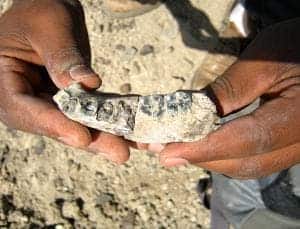A broken jaw unearthed in Ethiopia pushes back the origin of the homo linage – of which homo sapiens sapiens are the only surviving members – by 400,000 years. The finding might prove important in explaining how our ancestors diverged from more apelike relatives, like Australopithecus, to big brained beings, filling a blank spot two to tree millions years ago that’s still giving anthropologists headaches.
According to a team led by Brian Villmoare from the University of Nevada, Las Vegas, the fragment has been dated as being 2.8 million years old or 400,000 years older than any fossil of a homo species. Geological evidence suggests that the jaw’s owner lived in a time of shifting climate, when forests and waterways gave way to arid savannas – very similar to what we have today in the area, actually. Villmore believes this climate pressure may have been what jump started the accelerated evolutionary trend that eventually led to modern humans.
Although they only found a jaw fragment, the scientist were able to read a lot of clues about the person’s life almost 3 million years ago. For instance, it likely eat more meat than its ancestors and used tools judging from its delicate jaw. If you have tools, you don’t need to grind food or tree bark with your teeth.
[ALSO SEE] Humans grew bigger brains after eating cooked food
Another study made by researchers at University College London seems to strengthen the fossil’s Homo credentials. Using a medical scanner, the team reconstructed a badly preserved 1.8 million-year-old Homo Habilis skull and found striking similarities between its jaw and that found by Villmoare. As such, Villmoare’s fragment might belong to an ancestor that led to H. habilis and eventually our own species. Nothing is certain, however, until they can find more evidence. Digging again in the same area is a good place to start.
“In archaeology there is no sure thing,” he says. “All you can do is hope.”










